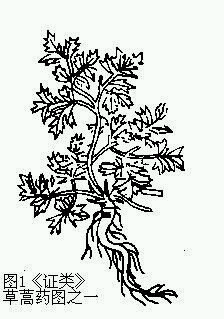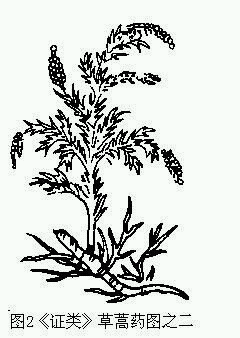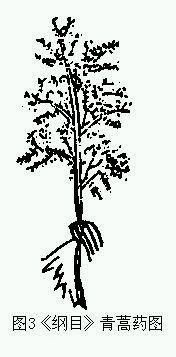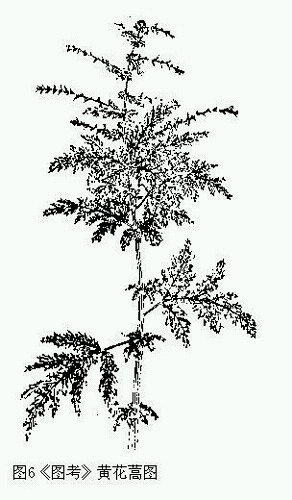| title | Sweet Wormwood |
| release time | 2006/8/24 |
| source | Jade Knock Studio |
Sweet Wormwood is the dried above-ground part of the plant Artemisia annua L. from the Asteraceae family. Sweet Wormwood was mostly wild in the past but is now widely cultivated, mainly produced in Youyang and Xiushan in Chongqing, as well as in Sichuan, Yunnan, Guizhou, Guangdong, Hainan, Guangxi, Zhejiang, Hubei, Anhui, Jiangsu, and other provinces.
Materia medica research suggests that the Sweet Wormwood used in ancient times came from various plants in the Artemisia genus of the Asteraceae family, including Artemisia annua. Around the Song Dynasty, Shen Kuo and Kou Zong-shi classified Sweet Wormwood into two categories based on its aroma, color, and edibility: those with a fragrant aroma, deep green color, and edible were likely Artemisia apiacea; those with a slightly foul smell, yellowish color, and bitter taste were Artemisia annua. Li Shi-zhen officially named the latter as "Huanghuahao" (Artemisia annua). Since modern times, it has been discovered that only Artemisia annua in the Artemisia genus contains artemisinin, which is effective against malaria. Therefore, starting from the 1985 edition of the Chinese Pharmacopoeia, Artemisia annua has been designated as the sole source of medicinal Sweet Wormwood. Artemisia annua is widely distributed, and there is no significant regional specificity in its medicinal use throughout history. Modern large-scale cultivation can select suitable regions based on the artemisinin content.
bubble_chart Variety Identification
"Hao" was a general term for a large category of herbaceous plants in ancient times. The "Book of Songs: Lu Ming" mentions, "The deer calls, eating the wild Hao," and commentators quote "Yanzi" saying, "Hao is the tall grass." Specifically, there are Baihao (called "Fan" in the "Book of Songs"), Louhao (called "Lou" in the "Book of Songs"), Niuwei Hao (called "Xiao" in the "Book of Songs"), Japanese Wormwood Herb (called "Wei" in the "Book of Songs"), and medicinal varieties such as Ai Hao, Virgate Wormwood, and Maxian Hao. These are mostly plants from the Artemisia genus of the Asteraceae family, and Sweet Wormwood is one of them.
The Bencao Jing mentions "Cao Hao" as another name for Sweet Wormwood, and the name Sweet Wormwood first appeared in the "Wushi'er Bingfang," which used Sweet Wormwood in a prescription for hemorrhoids and stated, "Sweet Wormwood is called 'Qiu' in Jing." The missing character in the text is partially damaged, and the compilers of the "Bingfang" believe it to be "Qiu." The "Yangsheng Fang" also specifically uses "Qiu." According to the "Erya: Shi Cao," "Xiao is Qiu," with Guo's annotation stating, "It is Hao," and Xing's annotation stating, "Xiao and Qiu are also rhyming in ancient times." The "Book of Songs" mentions "Xiao" in several places, such as "picking that Xiao" and "luxuriant that Xiao." According to Lu Ji's commentary, "What people now call Qiu Hao is also known as Niuwei Hao, similar to Bai Hao. It has white leaves, thick stems, grows in clusters, and can have dozens of stems. It can be used as a candle and has a fragrant aroma, so it is used in sacrifices with fat to create fragrance." If this is the case, the Sweet Wormwood called "Qiu" in the "Bingfang" is likely today's Niuwei Hao (Artemisia subdigitata Mattf.). Another theory suggests that the missing character in the "Bingfang" is "Qin," with the "Shuowen" defining "Qin" as "fragrant Hao." According to the "Erya," "Hao is Qin," with Guo's annotation stating, "What people now call Sweet Wormwood, fragrant and roasted for eating, is Qin." Xing's annotation quotes Sun Yan saying, "In the Chu region, Hao is called Qin." Lu Ji's commentary on the "Book of Songs" also states, "Hao is Sweet Wormwood. In the Jing and Yu regions, such as Runan and Ruyin, it is called Qin." However, there is still insufficient evidence to prove that this "Sweet Wormwood" called "Qin" is the same as the modern variety. In fact, from the Bencao Jing to the materia medica of the Song Dynasty, the variety of Sweet Wormwood was not very fixed, and there are many contradictions among various pieces of evidence, making it difficult to definitively identify it as Artemisia annua.(1) The reason why Sweet Wormwood is designated as Artemisia annua is almost solely due to its content of artemisinin, which has antimalarial activity. From the Bencao Jing to the Zhenglei Bencao, mainstream materia medica texts do not mention the efficacy of Sweet Wormwood in preventing malaria.
(2) Tao Hong-jing mentioned that Sweet Wormwood can be used as food. The "Jizhu" states: "It is the current Sweet Wormwood, and people also mix it with cilantro to eat." The "Shiliao Bencao" says: "It grows earliest in spring, and the white ones are naturally fragrant. They are pickled with vinegar and are beneficial to people." The "Bencao Yanyi" states: "Cao Hao is now Sweet Wormwood. It is found everywhere and is the first to emerge in spring. People pick it as a vegetable. Its roots are red and its leaves are fragrant. People today call it Sweet Wormwood, but there are also distinctions." Another example is Su Shi's poem: "Gradually feeling the east wind's chilly cold, Sweet Wormwood and yellow leeks are tried in the spring plate," all using Sweet Wormwood as food. However, Artemisia annua tastes bitter and is very unpalatable. The Sweet Wormwood referred to in the literature should not be this type.


(3) Most importantly, the two illustrations of Cao Hao (Sweet Wormwood) in the "Zhenglei" are quite bizarre. Figure 1 is hardly recognizable as a member of the Asteraceae family, while Figure 2 resembles a spike inflorescence and can barely be interpreted as Artemisia eriopoda Bunge. However, in any case, these two illustrations bear no resemblance to Artemisia annua.
On the other hand, some other sources indicate that Artemisia annua was indeed used as Sweet Wormwood during the Wei, Jin, Tang, and Song periods.(1) The "Zhouhou Beiji Fang" mentions a remedy for various types of malaria: "A handful of Sweet Wormwood, soaked in two liters of water, squeezed to extract the juice, and consumed entirely." It is now known that among the Artemisia genus, only Artemisia annua contains artemisinin, which has antimalarial properties. Therefore, if Ge Hong's record is accurate, the Sweet Wormwood used should be this type.
(2) The "Qimin Yaoshu" Volume 9 quotes the "Shici" on making Nu Qu using Sweet Wormwood, covering it from top to bottom. This method is still recorded in the "Tiangong Kaiwu," under the section on medicated leaven: "All medicated leaven used in medicine is distinct from the yeast used in brewing. This method originated in the Tang Dynasty. The leaven is not used for brewing. It is made exclusively with white flour, with every hundred pounds mixed with the natural juice of Sweet Wormwood, Polygonum hydropiper, and Xanthium sibiricum, formed into cakes, and wrapped in hemp or mulberry leaves, similar to the method of making fermented soybean paste." The Sweet Wormwood used in modern folk practices for making medicated leaven is still the strongly scented Artemisia annua.
(3) The entire plant of Artemisia annua contains volatile oils and has a distinctive odor. The "Shu Bencao·Tujing" describes Sweet Wormwood: "Its leaves resemble those of Artemisia capillaris but are not white on the back. It grows about four feet tall, and the seedlings are harvested in April and May, then dried in the sun. People in Jiangdong call it 'Quan+Xun Hao' because its odor resembles that of a 'Quan+Xun.' Northerners call it Sweet Wormwood." According to the "Guangyun," "Quan+Xun is a small beast with a foul odor, living in marshes, yellow in color, and feeds on mice." As described, "Quan+Xun" is likely an animal like a weasel. Comparing the odor of fresh Artemisia annua to that of a weasel, there is indeed some similarity, which is why this plant is also known as "Stinky Wormwood."
Faced with these two conflicting sets of evidence, we believe that until the Song Dynasty, medicinal Sweet Wormwood mainly came from various species of the Artemisia genus in the Asteraceae family, with Artemisia annua being just one of them.
If we set aside the perplexing illustrations of Cao Hao in the "Zhenglei," Shen Kuo and Kou Zong-shi, who were contemporaries of Su Song, seemed to notice the differences between Sweet Wormwood used as food and medicine and attempted to address them.
Volume 26 of Mengxi Bitan states: "There are many types of Artemisia. For example, the Sweet Wormwood category itself has two types: one with yellow flowers and one with green flowers. The 'materia medica' refers to it as Sweet Wormwood, but there may be distinctions. In the area between Sui and Yin in Shaanxi, there is Sweet Wormwood found among the Artemisia bushes, occasionally one or two plants stand out with a distinct green color. Locals call it 'fragrant Artemisia.' Its stems and leaves are identical to common Artemisia, but while common Artemisia is green, this Artemisia is a vibrant green, resembling the color of pine and cypress. By late autumn, when other Artemisia turn yellow, this Artemisia remains green and emits a slightly fragrant aroma. It is likely that this was the superior variety used by the ancients."
Kou Zong-shi's view is largely consistent with this. The "Yanyi" states: "Cao Hao is now known as Sweet Wormwood. It is found everywhere and is one of the earliest plants to emerge in spring. People pick it to use as a vegetable. Its roots are red and its leaves are fragrant. Nowadays, people call it Sweet Wormwood, but there are distinctions within the same category. Among them, the green variety is preferred. In the Suiyin region of Shaanxi, there is a type of Sweet Wormwood found among the wormwood clusters. Occasionally, one or two plants stand out with a distinctly green color, and locals refer to it as Xiang Hao (Fragrant Wormwood). Its stems and leaves are similar to common wormwood, but while common wormwood is light green, this variety is deep green, hence its fragrant aroma. It is likely that the ancients considered the deep green variety superior. Otherwise, why wouldn't all wormwood be green?"
Both Shen Kuo and Kou Zong-shi identified Sweet Wormwood by its deep green seedlings. However, it is difficult to pinpoint exactly which species of the Artemisia genus this refers to. It might be the Artemisia apiacea Hance, which later became a subject of controversy. Both texts mention "Xiang Hao" (Fragrant Wormwood), seemingly in response to the earlier "Shu Bencao·Tujing" description of Sweet Wormwood as having a "smell similar to 犭+卂." In terms of scent, it appears that neither author considered Artemisia annua to be Sweet Wormwood. More notably, the "Bitan" divides Sweet Wormwood into two categories: yellow and green, which laid the groundwork for the "Bencao Gangmu" to later add a separate entry for Huang Hua Hao (Yellow Flower Wormwood) alongside Sweet Wormwood.
The medicinal illustrations in "Bencao Pinhui Jingyao" were modeled after the "Zhenglei," but they were drawn to more closely resemble plants of the Asteraceae family's Artemisia genus. However, this did not contribute to the identification of specific varieties. Later, "Bencao Mengquan" clarified the relationship between Virgate Wormwood and Cao Hao (Sweet Wormwood). Chen Jia-mo stated: "There is a saying: 'March Virgate Wormwood, April Hao.' People often recite this, suspecting that the two are the same plant, differentiated only by age. However, although their leaves are similar, they are different species. Cao Hao has green leaves on both sides and produces flowers and seeds, while Virgate Wormwood has green leaves on the surface and white on the back, with no flowers or seeds. Moreover, they differ significantly in winter. Virgate Wormwood's stems do not wither; in spring, new leaves grow from the old stems, hence its name 'Virgate Wormwood.' Cao Hao's stems wither completely, and in spring, new shoots emerge from the roots, like grass regrowing, hence its name 'Cao Hao.' The old stems can be harvested in March, while the new shoots only mature in April. This refers to the timing of harvest, not the age of the seedlings." Although Chen's explanation does not resolve the issue of Sweet Wormwood's identity, his assertion that Virgate Wormwood and Sweet Wormwood are distinct is correct. However, it is puzzling that as late as the end of the Qing dynasty, Zhang Xi-chun still stated in "Yixue Zhongzhong Canxilu·Virgate Wormwood Explanation" that "Virgate Wormwood is the young seedling of Sweet Wormwood. In autumn, Sweet Wormwood produces seeds that fall to the ground and sprout, growing close to the ground like coins. Even in winter, with frost and snow covering the ground, the sprouts remain unharmed. By the Beginning of Spring (1st solar term), they grow vigorously and should be harvested in mid-January." According to Mr. Xie Zongwan, Zhang Xi-chun likely mistook Virgate Wormwood (Artemisia capillaris Thunb.) for Sweet Wormwood.
The "Bencao Gangmu" was the first to separate Huang Hua Hao (Yellow Flower Wormwood) from the Sweet Wormwood entry. The botanical relationship between Sweet Wormwood and Huang Hua Hao became a focal point of modern debate. To understand the origins of this issue, it is helpful to summarize the main content of the "Gangmu" regarding Sweet Wormwood and Huang Hua Hao as follows:
The entry on Sweet Wormwood in the Gangmu almost encompasses all the content of the previous materia medica on Sweet Wormwood. The section on naming takes five names: Sweet Wormwood, Fangkuai, Qin, Quanxunhao, and Xianghao, and adds a note: "Yanzi said: Sweet Wormwood is the tallest among grasses. According to the Erya, among all the Sweet Wormwoods, only Qin is simply called Sweet Wormwood. Could it be because the backs of the leaves of all other Sweet Wormwoods are white, while this one alone is green, making it different from the others?" The section on collection and explanation sequentially transcribes the annotations from the Bielu, Jizhu, Shu Bencao, and Bencao Tujing, but mainly adopts Kou Zong-shi's opinion on Xianghao and Chouhao, considering Xianghao as Sweet Wormwood and Chouhao as Artemisia annua. Li Shizhen states: "Sweet Wormwood sprouts in February, with stems as thick as a finger, plump and soft, and both the stems and leaves are deep green. Its leaves slightly resemble Virgate Wormwood, but both sides are green. Its roots are white and hard. In July and August, it produces small yellow flowers, quite fragrant, and bears seeds as large as hemp seeds, containing fine seeds inside." The section on indications synthesizes the discussions from the Bencao Jing, Xinxiu Bencao, Shiliao Bencao, Bencao Shiyi, and Rihuazi Bencao, and adds a new efficacy: "treating malaria with chills and fever." The section on attached formulas records four old formulas and adds thirteen new ones, among which the three formulas for "malaria with chills and fever" and one formula for "warm malaria with severe phlegm" are newly added by Li Shizhen.
In addition to quoting "Rihuazi Bencao" which states "Stinking Wormwood is also known as Grass Wormwood," and transcribing the efficacy of Stinking Wormwood seeds from the same book, the rest of the content is newly added by Gangmu. Shi-Zhen said: "Both Fragrant Wormwood and Stinking Wormwood can be named Grass Wormwood. This Wormwood is similar to Sweet Wormwood, but this Wormwood is green with a light yellow tint, has a pungent smell and is inedible. It is collected by people to ferment yellow wine."
Li Shi-zhen's classification is actually based on Shen Kuo's view, considering a plant with deep green color, fragrant smell, and edible as the authentic Sweet Wormwood. Therefore, all previous records of materia medica are retained under the Sweet Wormwood entry. This approach is in line with the traditional compilation practices of materia medica and is not inappropriate. Even Li's addition of the efficacy of preventing malaria to this edible Sweet Wormwood entry cannot be considered a serious error—although this efficacy has been proven by modern pharmacology to be absent in edible Sweet Wormwood—after all, similar additions are numerous in various materia medica. In fact, it is precisely because of Li Shi-zhen's relatively clear botanical description of Sweet Wormwood, combined with the somewhat inaccurate illustration of Sweet Wormwood in Gangmu (Figure 3), and Wu Qi-jun's recognition of Gangmu's discussion on Sweet Wormwood, along with the reference to the relatively standard drawing in Zhiwu Mingshi Tukao (Figure 4), that modern botanists have been able to identify the ancient Sweet Wormwood as Artemisia apiacea.




Similarly, the reason why Bencao Gangmu separates the entry for Artemisia annua is because Li Shi-zhen did not recognize the plant with a "pungent smell and inedible" mixed among the Sweet Wormwood varieties as Sweet Wormwood. Compared to the Sweet Wormwood illustration, the Gangmu illustration of Artemisia annua is more careless (Figure 5). Also, due to Wu Qi-jun's recognition and the accurate drawing in Zhiwu Mingshi Tukao (Figure 6), early Japanese botanists identified Artemisia annua as Artemisia annua. There is no objection to this conclusion from senior pharmacognosists who are well-versed in the evolution of materia medica, such as Mr. Zhao Yu-huang, Mr. Xie Zong-wan, and Mr. Chen Zhong-ming, as the facts are indeed so.
We cannot, because modern discoveries show that Artemisia annua contains anti-malarial Sweet Wormwood, disregard the facts and say that all Sweet Wormwood mentioned in ancient literature is Artemisia annua, or that medicinal Sweet Wormwood has always been Artemisia annua since ancient times. In fact, as Mr. Zhao Yu-huang cited in the 1930s in "Qizhou Yaozhi" from a report by Japanese scholar Ishido-ya, the Sweet Wormwood in Beiping is Virgate Wormwood Artemisia capillaris, while in Tianjin it is Artemisia annua. Mr. Zhao's view is that the northern pharmacies mainly use Artemisia annua, while the south uses Artemisia apiacea. The confusion over Sweet Wormwood varieties still existed after 1949. According to Mr. Xie Zong-wan's investigation, in addition to the above three types, there are many other plants used as Sweet Wormwood in various regions. It was not until the 1985 edition of Zhongguo Yaodian that Artemisia annua was designated as the sole source of medicinal Sweet Wormwood, before which Artemisia apiacea could also be used. Therefore, it can be confidently stated that before 1985, medicinal Sweet Wormwood was a multi-source variety, and Artemisia annua was only one of the sources.
bubble_chart Local Evolution
Artemisia annua is widely distributed, and there were no significant regional requirements for its medicinal use in ancient times. The "Compendium of Medicinal Production" states: "It is produced in all counties, with (Guangdong) Yingde County producing the most." This actually reflects the production situation of Sweet Wormwood in Guangdong during the Republic of China period. Modern standardized cultivation can determine suitable production areas based on the content of Sweet Wormwood's active ingredients.
bubble_chart Other Related Items




